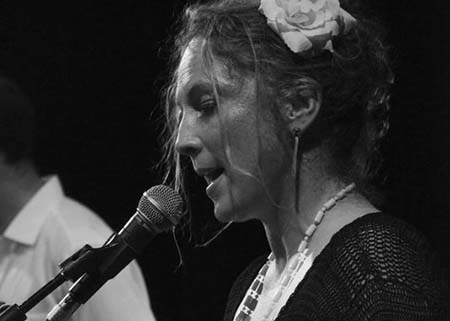
Image Credit to Rhys Jones
March 2017
Today, I listen
Sound emerges from the lambs' lungs,
the raven seeking out its own echo;
sound emerges as the bee, early,
fumbles in aubretia; the flies trapped
in strip lights, delirious;
the leather mallet dulls idle chatter,
lets the oak send out its long held vowels.
Sound of dog on hill, hail on tarpaulin,
and the carpenter with his drill
seeking something solid.
Heddiw, Rwy’n Gwrando
Sain yn tyfu yn ddwfn o ysgyfaint yr oen,
y gigfran yn hela ei adlais;
sain yn blodeuo o’r gwenyn cynnar
yn brysur mewn neithdar,
o’r pryfed caeth mewn stribed golau,
gorffwyll;
yr ordd ledr yn tawelu’r parablu
er mwyn gadael i’r dderwen ynganu'r
geiriau y bu'n eu dal mor hir.
Sŵn cŵn ar y bryn, cesair ar y to
a’r saer gyda’i ddril yn twrio
am loches gadarn.
A response to the Landscape Study Day at Llwyn Celyn Sept 2016
In Sept 2016 Clare was invited to attend and respond to the Landscape Study Day – a day of talks and sharing of knowledge about the Llanthony Valley and Llwyn Celyn’s place within it. The following selections of poems are taken from her full creative commentary.
Artistic Movements
We, in the threshing barn
hunker down to hear eight centuries
of art created in this valley of Ewyas,
this Llanthony Valley; rich tapestries;
slides of winged angels and romantic
elevating of the priory (re-named abbey);
Turner, Warwick-Smith, Sandby,
Hodges, Colt-Hoare, these men,
these men, these men felt
exalted, contemplated mixed pigments,
disturbed skies, stirred-up-rivers,
fixed ruins in their fine mellow yellow tints,
deepened lines, shadows still heightening
sunlight, sunlight on the valley.
We, in the threshing barn snapped back
from Gill’s Nude Girl with Hair, by a turbulent
thwack of the tarp at the doorway.
What’s it keeping out as we wander
wonder Wordsworthian, learning landscape
through art, learning place from
the tip of this speaker’s tongue,
the hiss and hum of the projector
(and the bats quiet in the rafters,
their stories still wing-tucked)?
Beyond the barn in Llwyn Celyn’s demesne,
in the once-grounds by the stone wall being rebuilt
the damascene tree, damson
plums, drupaceous, testicular,
purple bold against its green,
skins bulging with unmade ink;
the dyer gathers her trug, will boil,
release autumnal colours from slumber
—will stain her fingers, the page.
Hatterrall Ridge Visitation
Heart-thumping hike up the old beer path,
the heady stink of sheep’s piss—the need to rest; I sit on a dead chestnut tree,
mist falling behind me, consuming the ridge, falling over the valley;
beyond the priory, sun beams part cloud, highlighter on the hill’s cheek.
The sheep marked M don’t shoot off spooked,
they lie down fully woollen-spread, chewing,
chewing, taking me in, wondering, wondering. Or not.
Somewhere on this hill, Allen Ginsberg in fifth hour
of LSD enlightenment, wrote ‘Wales Visitation,’
his face pressed down to the brown sweet ground here,
heard the undulations and pulsations of the earth speak
breathing at one with the trees and grass and chewing jaws
of these same exotic sheep. The wool in my jumper excretes
mountain smell, a synesthetic call to its flock—I feel its undoing,
its thread unravelling, faint umbilical to this ewe here done
pausing, relieves herself of my gazing, rises; I go to the crib of grass
palms down, feel the warmth of beast and moist humus of poet sigh,
elemental, transferring knowledge of connectedness.
From the deep green of Landor’s larches, the raven gauk, gaurks
rasping the now mistless air, making lines of verse untraceable in the sky
instead read deep in ear, corvid-speak meeting cochlea, outer, inner.
The sun blazes, coruscating sheep droppings, rabbit cecal pellets,
lucid clumps with their molecular mucous cling to hill, grass to grass in ebony shine.
As I descend, face the priory, six miles from Llanvihangel Crucorney,
I feel the presence of those who walked here,
centuries of hill signatures made by cart and hoof and foot,
and I, here, too, facing the ruins of Llanddewi Nant Honddu,
sing with harmony as I move slowly away from the boundary
between languages, stop becoming observer, lyrical documenter;
I become amanuensis to this landscape